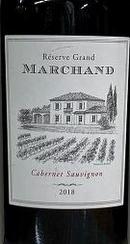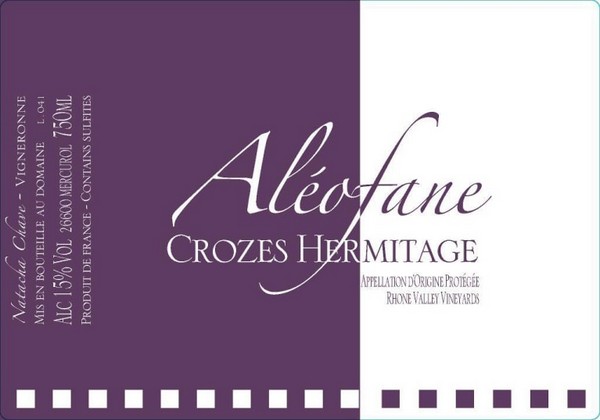November 2022 CASE Club
tatomer white wine blend ‘hinter der mauer’ (Organic)
Vullien Jacquère (organic)
vignerons de grimaud Fleur de Provence Rosé (practicing organic)
Reserve Grand Marchand Bordeaux (Sustainable)
hElLER sYRAH vdp fRANCE bONNE fORTUNE (Organic)
Sobon Zinfandel Rocky Top (practicing Organic)
Santiago Ruiz White Blend O Rosal (Practicing organic)
VOIRIN-JUMEL CHAMPAGNE NV Tradition (ORGANIC)
Commanderie de Bargemone Côteaux d’Aix en Provence (Organic)
Dom. Natacha Chave Aléofane Croze Hermitages (Organic and Biodynamic)
Lano Langhe Nebbiolo (organic)
Bedrock Old Vine Zinfandel (Organic and Biodynamic)
tatomer white wine blend ‘hinter der mauer’ (Organic)
“Hinter der Mauer” is an Austrian-German term that Graham Tatomer learned while working harvest in Austria at Emmerich Knoll which roughly translates to “your back against the wall”. The room between the walls of the terraces of the vineyard and the vines he would work on was very tight and this feeling of having your back against the wall is something very familiar during the COVID-19 pandemic, when Graham decided to blend some of his more expensive wines that were not selling because much of his customer base was the restaurant trade and they were all shut down. He created Hinter as a way to sell his wine at a much lower profit to retail customers, and the wine sold out very quickly.
This wine is an homage to his time in Austria working these vineyards and is expressed through these diverse sites throughout the Central Coast of California. There is a sense of being squished. But it often produces some of the best tasting fruit due to the radiant heat from the stone wall next to it. Graham learned this term one jovial evening with the Knoll family, when they were all sitting around the table enjoying wines and they were teaching him some Austrian dialect terms that they were both proud of and entertained by. Hinter der Mauer is not only Austrian but distinctly a “Loiben Village” term. It would not even have the same meaning in other areas of the Wachau
There is no variety listed on the front label, just that name, 2021 Central Coast, California. On the back label the blend is listed as 80% Grüner Veltliner 20% Dry Riesling. The vineyards in this cuvée are Kick-on Ranch, John Sebastiano, Paragon, Oliver’s, and La Estancia.
An SF Chronicle Wine of The Week in 2021
Vullien Jacquère (organic)
The eastern French region of the Savoie is one of the most exciting wine regions on the planet, and it’s near the top of my must-see places to go. Savoie is blessed – a cool mountain climate on a warming planet, and about as idyllic a place to grow and make wine as one could ask for.
Known more for skiing and other outdoor pursuits, the Savoie is not so well known as a wine-producing area, though within the area known as the Combe de Savoie, there are a handful of the best producers.
With little-known grape varieties such as Jacquère, Mondeuse, and Altesse nestling alongside Pinot Noir, Chardonnay, and Gamay, the world of Savoie wines begs to be explored. I was astonished at the quality of Jean Vullien’s wines, especially when compared to most other producers in the area. How were they producing such high-quality, clean, and fresh wines when so many others clearly couldn’t? It transpired that Jean Vullien learned viticulture in his native Bordeaux and his two sons, David and Olivier graduated from the renowned wine college, La Viti in Beaune.
The region’s best come from a boomerang-shaped string of hillside villages between Grenoble and Albertville (site of the 1992 Winter Olympics) called the Combe de Savoie (Combe is a word of Celtic origin meaning a sharp, deep valley). Jean Vullien and his two sons, David and Olivier, tend 69 acres on the Combe in the villages of Chignin, Montmélian, Arbin, St-Jean de la Porte, and their hometown of Fréterive.
The domain’s holdings include all of the region’s indigenous grape varieties, as well as strategically-placed parcels of Chardonnay and Pinot Noir. The wines range from a crisp, lemon and mineral Jacquère-based white that British wine author Andrew Jefford would categorize as “Muscadet of the Alps” to complex floral and spiced reds made from Mondeuse. In recent years, David and Olivier have also earned a reputation for their excellent Méthode Traditionelle sparkling wines.
Though the Vulliens have been making wine for 40 years, the family is perhaps best known as a leader in another segment of the wine industry. Since 1890, Vullien Pépinière Viticole (vine nursery) has been supplying young vines to growers throughout France. In fact, they were the source for about 25% of the Chardonnay planted in Chablis after the ravages of phylloxera.
Climatically, the Savoie is more challenged than many other wine-producing areas of France, hence the different native grape varieties. Jacquère, which is widely available, drinks like a dry Sauvignon Blanc and is superb with shellfish and seafood. Gamay, which is the principal variety of Beaujolais, is comfortable in this slightly cooler climate too. They are succulent, light and full of fruit with the Gamay Rose airing more on the side of a dry rose. Both work extremely well with Savioe dishes such as raclette, tartiflette, tarte flambée (flammekueche), and cheese fondues.
Jacquère is a variety of white grape found primarily in the Savoy wine region of France. It is a high-yielding vine variety that is used to produce lightly scented, refreshing and gently aromatic dry white wine, such as Vin de Savoie. Jacquère is the grape used in Apremont wines and is the usual wine paired with cheese fondue (a dish from the same region). Vullien‘s 100% Jacquère is grown on soils of dark Jurassic limestone and black marl with a pebbly topsoil layer of scree. The wine is fermented in stainless steel tanks and the malolactic fermentation is blocked. The resultant wine is light, mineral and brightly acidic with notes of alpine flowers and citrus. Enjoy as an apéritif or with fondue or mountain cheeses.
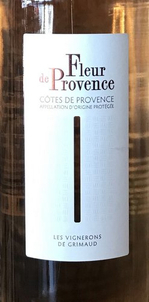 Fleur de Provence Rose (Organic)
Fleur de Provence Rose (Organic)
Vignerons de Grimaud is a co-op founded in 1932 by over 100 family-owned vignerons (winegrowers). It is situated near the gulf of Saint-Tropez and the heart of Provence. Today, the cellar now has more than 270 members spread over 12 municipalities.
Mainly planted with Grenache, Syrah, Cinsault, and Rolle (Vermentino), the vineyard producing this wine is located on the slopes perched at 500 feet in altitude, where it benefits from unparalleled sun exposure and the maritime winds blowing in from the Mediterranean Sea just a few kilometers away. Each varietal was planted on the most suitable parcel, allowing it to flourish and mature fully. The terroir is predominantly sandy-schist and limestone which allows the roots to grow very deep, making the vines more drought-resistant and contributing to the complexity of aromas and overall finesse of the finished wine.
This rosé blend is roughly 50% Grenache and 50% Cinsault. The grapes went direct to press with minimal skin contact, leading to the pale salmon color. The must was cold-fermented to preserve the aromatic freshness, and was matured in stainless steel.
Pale pink. Delicate aromas of strawberry and raspberry open to flavors of cherry, Jolly Rancher, alpine strawberry, and wet stone, and close with a wonderful burst of refreshing acidity on the finish. In true Provence style, this rosé is crisp, refreshing, and dry. It might even succeed in transporting you to St. Tropez.
Reserve Grand Marchand Bordeaux (Sustainable)
This 100% Cabernet Sauvignon wine comes from the eastern ends of the Entre-deux-Mers appellation (which is designated for whites only, thus the generic “Bordeaux” label). It is full of black fruits that balance the firm, dry tannins. Juicy acidity bursts in at the finish.
Winner of a gold medal from the Concours Générale Agricole de Paris.
Réserve Grand Marchand belongs to the Barthez Family. Jean-Marc Barthez, his wife Eliane, and their children are working at the property and in their vineyard with the care and experience of old-generation vine growers.
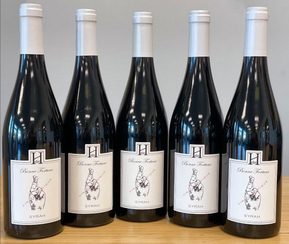 Heller Syrah Bonne Fortune (Organic)
Heller Syrah Bonne Fortune (Organic)
Quentin Heller’s lives in the Rhone Valley, where his extensive network influenced him to create his own wines. Grapes are sourced from unique, old vine sites in the Rhone and elsewhere, and vilified with minimal
intervention. He is a passionate, enthusiastic, entrepreneur full of ideas. Working alongside small winegrowers in the Rhône Valley and Beaujolais for years, he got caught up in the winemaking game, and launched his own brand in 2020. The Heller brand is an artistic outlet and a space of total freedom which does not only consist in putting a name to a bottle.
90 points, James Suckling: “Delicious seems to me to be the word here! Big, with plenty of blackberry and a lot of freshness, this bold red is brimming with ripe but not overripe fruit. Very clean and straight. A blend of 2020 (80%) and 2021 (20%) vintages.

Sobon Zinfandel Rocky Top (practicing Organic)
Sobon Zinfandel Rocky Top is made by the Sobon family in Amador County. The winery was founded when the Sobon’s purchased the old d’Agostini (designated a State Historic Landmark) and started producing deep-structured wines using sustainable and organic farming methods.
We’ve carried Rocky Top for fifteen or so years, and really like its bold flavors and brambly fruit. Produced entirely from Sobon’s organically farmed estate old vine vineyards in the Shenandoah Valley, these special vines yield intensely concentrated Zin full of ripe blackberry and cherry fruit aromas and flavors, with hints of chocolate and that classic Amador spiciness. It is a perfect match for roasts, steak, and rich sauces, and will complement aged, full-flavored cheeses.
From one of the few remaining blocks of pre-prohibition era Zinfandel on the Estate, this ridge-top vineyard of cobble loam gives us a full-bodied wine of great depth, structure, and character. From dry-farmed sustainably grown vines, offering inviting notes of summer berries, licorice, and a woodsy earthiness with hints of white pepper and allspice. Heady aromatics lead to a rich, long, lingering finish.
Aged 18 months in small French & American Oak barrels, 30% new Tasting Notes: Notes of summer berries, licorice and a woodsy earthiness with hints of white pepper and allspice. Heady aromatics lead to a rich, long, lingering finish.
The Sobon Estate winery started in 1989 when Leon and Shirley Sobon bought each other a second winery for their 30th wedding anniversary present. They purchased the historic D’Agostini Winery, one of the oldest in the state. This winery has been designated as California State Historic Landmark #762. This site was chosen not only for its historical winery but also for its vineyards and vineyard land.
The old vine Zinfandel was retained, and the other vineyards were replanted with the best varieties and clones. The Sobon Estate label launched the estate line of wines for the Sobon Family — the best wines from their own grapes. Over the years, Leon garnered many National and International awards for Sobon Estate and Shenandoah Vineyards wines. Both family label wines are distributed nationally, as well as internationally in Canada, Switzerland, and Hong Kong. Leon is widely recognized as a leader in the wine industry and has actively participated in many industry boards and committees. He is also sought after as a judge for many prestigious wine-tasting competitions. Today … the winemaking and business aspects continue to be a family affair. Shirley is the Finance & Gallery Manager while Leon contributes his years of winemaking knowledge to every vintage. Sons Paul, Robert, and Son-in-Law Tom Quinn continue the family tradition that began all those years ago.
91% Zinfandel, 9% Carignan. “Full aromas of ripe black fruit, cooked cherry, and hints of toasty smoke. Round and full on the palate, with blackberry, plum and cinnamon, over a peppery spice. Balanced, rich finish ending on a dark chocolate note.”- Sante Magazine
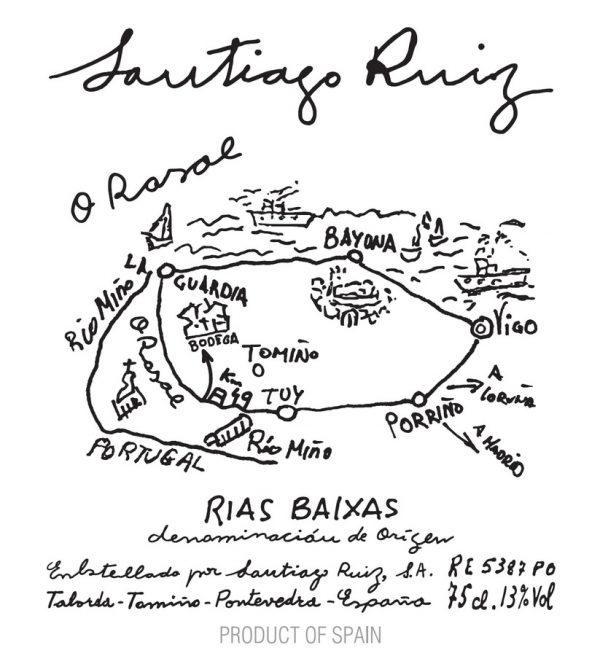
Santiago Ruiz White Blend O Rosal (Practicing organic)
Most talk of Albariño wine inevitably leads back to talk of Bodega Santiago Ruiz and its founder, Mr. Santiago Ruiz, a man hailed as the “inventor” of Albariño wine. Located in the district of O Rosal, the bodega is one of the leading producers in Rias Baixas. Santiago Ruiz was a visionary, decades ahead of his time. In 1978 at the age of 70, retired from his everyday work obligations, he decided to devote his newfound free time to his real passion by following the tradition of his ancestors (His maternal grandfather was one of the first winemakers in Galicia, founding his own bodega in 1860).
A stout defender of the quality of native grapes, Santiago Ruiz became an ambassador for Rias Baixas’ wines, traveling the length and breadth of Spain (mostly on foot), with the clear objective of heightening awareness of Rias Baixas among the most select restaurateurs and opinion leaders of the early 1980’s. He was convinced that Albariño could give rise to some of the best white wines in the world, and his trailblazing work has clearly made a mark in the wine world, with Rias Baixas Albariño now considered a “must have” on any thorough wine list or cellar.
The Ruiz family’s winemaking roots on Galicia’s Atlantic coast go deep. Ángel Ruiz, the grandfather of the eponymous Santiago Ruiz, was making wine here in the 1860s and was one of the first people to bottle wines from the region we now know as Rías Baixas. Santiago, however, was the first to market the Estate wines, selling his first twenty boxes of Vino de El Rosal to a restaurant in Vigo in 1981. Today, the Estate is run by Santiago’s daughter Rosa, aided by the winemaking smarts of Luisa Freire.
The core vineyards lie at Tomiño in O Rosal – the most southerly of Rías Baixas’ five subzones. Situated on the top lip of the river Miño (which marks the border with Portugal), O Rosal enjoys more sunlight hours and a drier climate than Rías Baixas’ other subzones. The vineyards here also benefit from cooling Atlantic breezes and the moderating influence and airflow from the river. Soils in O Rosal are predominantly sandy over granite bedrock, though they vary in texture. This set of natural circumstances favors a style of wine that is both ripe and mineral-laden at the same time, with the granitic soils and cool Atlantic nights providing crisp energy and drive.
A blend of mostly Albariño, this wine is refreshing, brisk, crisp, complex, and a lot of fun to drink. Intense and complex aromas of blossom, pear, apple, and citrus fruit characters, anise seed, and some subtle spicy notes. Concentrated flavors on the palate are carefully balanced by clean acidity and stony minerality. Packed with flavor, it has a long and crisp finish.
The O Rosal sub-region is the most southerly in Rías Baixas, sited along the Portuguese frontier in the basin of the river Miño and extending from the Atlantic coast inwards towards the town of Tui. The vineyards are planted on terraces on the banks of the river on alluvial soils. Spread across the exposed sunny slopes of Tomiño and mimicking the traditional blend of an O Rosal wine, Santiago Ruiz’s vines are devoted to guyot-pruned plantings of Albariño, Loureiro, Caíño Blanco, Treixadura and Godello (in decreasing order).
A wine labeled with the sub-regional designation of O Rosal must contain Loureiro, and here (where the component hovers around 10%) the controlled yields of the variety bring ripe citric drive and notes of blossom to the blend. With an unusually high percentage of Albariño this year, it weighs in at 76% Albariño, 11% Loureiro and 5% Treixadura, with the balance Caíño Blanco and Godello. Each variety was individually fermented and raised for six months on lees in stainless steel before blending and bottling.
All the vineyards are sustainably farmed: harvesting is carried out by hand; organic fertilizer is the norm; cover crops between the rows are encouraged and pesticides and herbicides are banned. Santiago Ruiz was instrumental in introducing stainless steel to the region.
 VOIRIN-JUMEL CHAMPAGNE NV Tradition – ORGANIC
VOIRIN-JUMEL CHAMPAGNE NV Tradition – ORGANIC
Jean Voirin, who owned some vines and sold all his grapes in bulk, decided to begin bottling his own champagne at the end of World War II. The Jumel family started producing champagne around the same time—René Jumel had a transport business and his wife’s family had some vines that they cultivated. As the champagne market grew, René began selling some of his trucks and buying vineyards around the Côte des Blancs, which his wife, Paulette Richomme, worked and oversaw. Between 1950 and 1970, all the grapes were sold in bulk.
In the early 1970’s, Françoise Jumel (daughter of Paulette and René) began bottling champagne with her husband Gilles Voirin under the name Voirin-Jumel. That year they sold nearly 10,000 bottles. In the 1990s, Françoise’s children, Patrick and Alice, along with Patrick’s wife Valerie, began running the domain.
Today it is a true family affair, and they own 30 acres of vines in 11 different villages (broken down to approximately 10% Cramant, 20% Chouilly, 10% Avize, 5% Oiry, 10% Oger, 10% Mareuil-sur-Ay, 10% Vertus, 15% Verneuil and the remaining 10% in 3 other villages).
Each lot of grapes is vinified separately and each tank goes through malolactic fermentation. In January, the wines are stabilized. Shortly thereafter, the vins clairs (still wines) are tasted and it is determined which lots will be used for each specific release. All the champagnes are given very low dosages, and are aged for three-four years minimum, thus ensuring fresh, lower-acidity champagnes that really highlight their varied terroirs. All their production is bottled and sold at the domain.
The Tradition Brut NV bottling is a blend of 50% Chardonnay and 50% Pinot Noir from the Côte des Blancs and Vallée de la Marne, this is the domain’s “entry level” champagne, perfect for any occasion. Its aromas and flavors of red fruits, hazelnuts, and almonds are balanced by a pleasant liveliness. Based on 2018 with 20% reserve wines, from 50% Vertus Chardonnay and 50% Verneuil Pinot noir. Dosage 6g/liter. This is a wonderful fresh Champagne with lovely citrus and minerals.
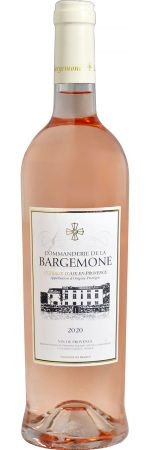 Commanderie de Bargemone Côteaux d’Aix en Provence – Organic
Commanderie de Bargemone Côteaux d’Aix en Provence – Organic
Bargemone is among the foremost estates of the Coteaux d’Aix, a small fine-wine district in the larger appellation of Provence. With more than 160 acres under vines, 2/3 of the production is dedicated to the dry rosé for which Provence is famous.
‘La Commanderie de la Bargemone’ was founded in the 13th Century and is located 10 miles away from the historic city of Aix-en-Provence. In 1250 AD – The Knights Templar built their compound of buildings known as ‘’La Commanderie” in the heart of the surrounding farm fields. In 1968 – The vineyards were replanted on a large scale with 300 acres (120 hectares) in production.
The vineyard ‘’La Commanderie ‘’ is a traditional Provence vineyard that has been dedicated to producing Rosé (90+%) & White (10%) ‘’Côteaux d’Aix en Provence” of the highest quality for few decades.
The property was named “Bargemone” after the wealthy Provençal family that owned it for 200 years. It passed from their hands in the 1800s, with the vineyards finally succumbing to phylloxera, temporarily ending, a proud 800-year tradition of winemaking. In 1973, French industrialist Jean-Pierre Rozan purchased the property, restored the Commanderie, and replanted the vineyards. Production was up to 50,000 cases/year when Jean-Pierre passed away in 2006, and a controlling interest in the vineyards and winery was sold to current owners Christian and Marina Garin (both from local Provençal families).
The vineyard essentially represents a single terroir, with almost identical soils and exposures, aiding the production of wine of remarkably consistent quality with production of selected grapes such as Sauvignon Blanc, Rolle, Syrah, Counoise, Caladoc, Grenache, Cabernet Sauvignon. Viticulture and winemaking are 100% organic and certified Organic by EU. This is literally the beating heart of ‘’La Commanderie”.
Offering classic aromas of wild strawberries and red currants, with a light, floral character, and a crisp, bone-dry palate, this is a rosé of reference, to be enjoyed year-round on its own or with a wide range of lighter fare and Provence-inspired cuisine. Cabernet Sauvignon, Grenache, Syrah, and Cinsault from 25+ year-old vines. Stainless steel vinification. Two days settling at cool temperatures followed by a cool, ten-day fermentation. No malolactic fermentation.
40% Grenache, 25% Cabernet Sauvignon, 20% Syrah, 10% Cinsault, 5% Rolle.
Dom. Natacha Chave Aléofane Croze Hermitages (Organic, practicing Biodynamic and following Natural wine principles)
At a very young age, Natacha Chave knew that she would make wine, just like her parents. At the beginning of 2000, her brother Yann Chave took over their father’s Domaine (Bernard Chave) , a renowned vineyard created in 1970 on the Crozes-Hermitage and Hermitage appellations. He renamed the Domaine and renamed it Yann Chave.
So, Natacha knew that if she wanted to make her own wine, she needed an education, some land, and a winery. Natacha enrolled at the Suze la Rousse wine university in 2003, then passed a Farming Professional Capacity (CPA), and then did her work experience with various winegrowers to complete her training. In 2004, she bought 4 acres of vines in the Saint Joseph appellation at Tournon-sur-Rhône. In 2007, she bought a plot of 40-year-old vines in Crozes-Hermitage appellation in the Chassis plain (Beaumont-Monteux village) and planted a few additional vines reaching extending her Domaine to 16+ acres.
The name of the Domaine is Aléofane, in reference to the imaginary island from a book by author, John Macmillan Brown. According to Natacha Chave, “Our immediate will is the respect of nature, soils, grapes and is to be as little as interventionist as possible both in grape growing and in the winemaking process.”
Grass covering between rows, total work of the soil according to the years to induce or not a competition with the vine. And she goes on with vinification: indigenous yeasts and no enzymes. No filtration, no fining and as little sulfur as possible. Natacha also uses biodynamic preparations that favor the stimulation of the plant’s natural immunity and its balance. — Natacha’s approach is very time-consuming, but the payoff is well worth it.
Dense and concentrated; but even with this concentration of fruit, she manages to maintain a beautiful balance. Lovely to drink now and will develop and improve with a bit of aging. This Crozes is 100% Syrah from 50-year-old vines that will blow you away. From an organic vineyard, hand-harvested, native yeast fermented, unfined and unfiltered. The wine is deep in color, purple tinged, concentrated, but perfectly balanced. Black fruits galore, black pepper, Asian five-spice, and savory. It’s best to open it an hour before drinking, it was still great on day two and still hanging in there on day three after opening.
90 points, Decanter: This is a totally classic example. It’s a well-balanced, fruity, and satisfying style of Crozes with good ripeness of fruit, but a gently grippy tannic structure and enough acidity to balance. Decent length. A little reductive on the nose, but not problematically so. A blend of biodynamically-grown parcels of Syrah from around the Chassis. Matured mostly in demi-muid, but also stainless steel and concrete eggs.
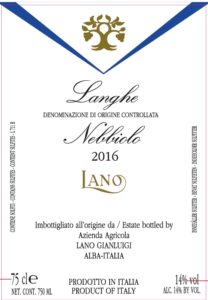 Lano Langhe Nebbiolo – organic
Lano Langhe Nebbiolo – organic
Gianluigi Lano is a reserved, contemplative person. He understands the importance of his land and takes pride in what he has. This is why he chose to bottle his father’s grapes in 1993; no longer willing to sell them to the local cooperative. The weight of that decision is reflected in his fanatical farming standards and in the quality of his wines. With no family winemaker to look up to and no reputation to rest on, bottling his own wine would lay bare his hard work, skill, and conviction.
Lano Gianluigi farms the right way; his wines are recognized as true wines of terroir; long aging and typically vin de garde in style.
Where many Barbaresco producers underlying the current renaissance choose a style based more solely on fruit and generous structure, the wines of Lano Gianluigi are decidedly medium-bodied yet strictly structured- with great refinement and powdery tannin to complement the beautiful aromatic intensity. The Barbaresco Rocche Massalupo is for the true Barberesco connoisseur – as sculpted and precise as a steel beam – with the solidness to match. There is a regal restraint that is something to marvel at in youth and truly engage with as the develops with age. It’s difficult to consistently have wines throughout the range of such striking structure in medium-bodied, precise frames. The consistency of Lano Gianluigi is truly on par with more famous, elite Barbaresco producers.
This wine is declassified Barbaresco Rocche Massalupo. Traditionally, this wine is only 1/3 declassed Massalupo, but 2019 was a hot year and Gianluigi decided to declassify most of the fruit and make this cuvée 100% Massalupo. Fine tannin, an acidic backbone, and precise aromatics are finely woven into the fabric of the wine, rendering a complete wine of great pleasure. This is truly a standalone Nebbiolo as opposed to the introduction to it. This wine rewards well over five to 10 years of aging as the secondary aromas that make Nebbiolo so compelling become more present
Gianluigi, Daniela and Samuele (Son), preside over the vineyards and cellar. The family farm is next to the Rocche Massalupo cru, just down the hill from the village of Treiso. All vineyard parcels are a combination of calcareous clay and sand, with Nebbiolo generally planted on plots with a higher percentage of clay. The most important plots have vines between 30 and 50 years of age.
Organic certification was completed in 2018, however, their farming standards are much deeper. A green harvest is completed early in the season to concentrate growth on a small number of grape bunches. Cover crop between the vines is uninhibited in the summer, with periodic cutting between rows only to provide nutrients back to the soil. They do not even use natural fertilizer and no treatment of any kind is applied after the first week in July, ensuring a particularly pure and clean crop at harvest. This greatly increases risk, but it’s a decision that is consistent with their contemplative nature and strict farming standards. The family finds better balanced wine and smoother spontaneous fermentation when biodiversity is present in the vineyards. Samuele explained in detail how they use natural algae treatments to fight mildew, as an alternative to copper.
The family also allows ample canopy growth and rarely thins the canopy. If the canopy is too thick, chutes are tied together, preserving ripening capability while also promoting air circulation. As Samuele reiterates, farming decisions are always to foster the necessary biodiversity to support cellar practices that best showcase individual plots, such as spontaneous fermentation.
In the cellar, their goal is simplicity. Cement without temperature control is employed for primary and malolactic fermentation while old oak casks see most of the wines through a long, cool élevage (in the winter months, one is wise to bring a warm hat into the cellar). Cement is considered quite traditional and used by many of the finest producers in the Langhe; naturally regulating temperature. Use of sulfites is extremely low and only used for bottling or “rack and return” activity. All wine is bottled without fining or filtration.
The wines all share powdery tannin and medium body with well judged ripeness leading to fruit at the cooler end of the spectrum. Old vine Barbaresco Rocche Massalupo and single vineyard Barbera d’Alba are the cornerstone of a deeply serious range of wines made to keep, each with a transparency, intensity and intellect expected of Italy’s finest appellations.
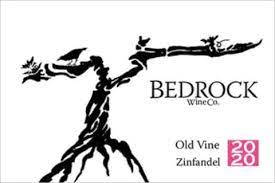 Bedrock Old Vine Zinfandel- Organic and Biodynamic
Bedrock Old Vine Zinfandel- Organic and Biodynamic
Bedrock Wine Co. was founded in 2007 by Morgan Twain-Peterson in a 550 square-foot, former chicken coop with ceilings eight feet high and no fermentation space.
After six years of Bedrock being a one-man-show, Morgan was able to talk his best friend, Chris Cottrell, into moving to California from New York to join him. They now happily have a little more space to move around in but share the same objectives that guided the winery at the start. Bedrock Wine Co. is fundamentally about making wines that are hopefully a soulful expression of a vineyard and a year. Too often though, the critical link that binds a site to the winery is forgotten- the grower. It has been said a thousand times. It does not make it any less true. Great wine is made in the field.
Morgan Twain-Peterson was born at home in Sonoma, Ca. On January 6th, 1981 to Joel Peterson and Kate Twain. Raised at his father’s Ravenswood Winery, Morgan was exposed to wine and wine tasting at an early age. In David Darlington’s Angel’s Visits, it is noted that, “Morgan, at the age of five, could distinguish between Merlot and Zinfandel.” Morgan began making small lots of Pinot Noir at 5 from fruit given to him by the Sangiacomo family. Motivated by the best wines of Domaine Dujac, he began experimenting with whole cluster fermentation, different types of French oak, and various ripeness points. Vino Bambino Pinot Noir, as the wine came to be known, was made from 1986 to 2001 and has been featured on the wine lists of Craft, Gramercy Tavern, Blue Hill (which featured the original 1986), Delmonico’s, Aureole, and Mesa Grill. While doing undergraduate work at Vassar (whose founder was a brewer of all things), and graduate work at Columbia University, Morgan worked as a wine buyer and salesperson for Arlington Wines and Liquors in Poughkeepsie, and Chelsea Wine Vault and Pet Wines in Manhattan. Morgan returned home to Sonoma in 2005 to work harvest at Ravenswood. From there he spent time as a visiting winemaker at Hardy’s Tintara in McLaren Vale (where he also spent a few highly educational days with Drew and Rae Noon at Noon Winery), and in the fall of 2006 was a visiting winemaker at Chateau Lynch-Bages in Pauillac. When not working for Bedrock Wine Co., Morgan is a manager of his family’s Bedrock Vineyards in Sonoma Valley, and is a member of Sunbreak Vineyard Services L.L.C, a vineyard management company run by Diane Kenworthy and Robert Burney. He has also passed the prestigious Master of Wine exam and upon successful completion of the dissertation will become one of the (less than thirty) American Master of Wine.
From Winemaker Morgan Twain Peterson, MW: In our experience, simple is often times the best. This stems from a personal belief that wines heavily manipulated and overly sculpted by activist winemakers tend to be less satisfying and soulful gustatory experiences whether they be from Sonoma, Lodi, Amador County, Chambolle Musigny, Gigondas or Serralunga.
The biggest contributor to the 2020 Old Vine Zin is Bedrock Vineyard, which boasts vines up to 130 years old. The Bedrock team also tapped Esola Vineyard in Amador County (planted in the 1960s), Schmiedt Road (1910s), and Evangelho and Nervo, both of which date back to the 1890s. As usual, almost all of the wine consists of declassified barrels from vineyard-designated wines, so it offers serious bang for the buck. 85% Zinfandel with the balance a blend of Carignan, Mataro, Grenache, and Alicante Bouschet, along with esoteric creatures like Aubun, Abouriou, and many more.
This is more than a gorgeous Zin from an iconic producer: It’s a tribute to California’s winemaking history, and to what time and dedication can bring to the bottle.





